The Chicken Run is the next most expensive thing you will buy, next to chicken houses and is most likely to be the weakest link as far as predators like foxes are concerned.
In order to come up with a sensible sized run, you will need to ask yourself the following:
- How many chickens will I have? Always assume a couple more because it is a very addictive hobby and you will soon be tempted to add a couple more hens to your flock!
- What space do they need? There are guidlines but legally a battery hen has enough space…. so perhaps you should consider what a fair size run would be for them to move around in, scratch, dust bath, feed and drink and whether there is enough room for them to get away from another hen if pecked.
The run is there to contain your chickens but also to protect them from predators. We have a number of different chicken runs and I have used several designs over the years but every time I visit a friend who has lost chickens to the fox, they say the same things, either “I didn’t want to spend….” or “I didn’t have the time to…” and “the fox got in through here…”
So lets look at the options, you can pay for a chicken run that will cost you money or you can build a chicken run that will cost you in time but is less money!
Buying a Chicken Run
Most of the chicken runs that you can buy to fit onto a coop (or that are built into a coop) are rather small in my opinion. There is an answer to this though. Use this run for your girls when the weather is really bad or when there is a higher risk of predators but at other times, open the door and let them out!
The down side to this is that they will spoil a small garden over time with their scratching and dust baths, will eat some of your plants and will leave droppings on paths for you to step in! The good news is they get to free range and will be far happier and healthier hens, you can enjoy having them out and can limit their time out a little to allow the garden to recover. You can of course fence chickens into a certain area of the garden which can help if you have plants that you don’t want destroying.
An alternative to letting them out of their run is to use a portable run so you can move them around onto fresh grass at regular intervals. I have done this regularly with my young growers but be warned they soon spoil the ground and need moving every few days if the grass is going to have a chance to recover so make sure you get a house and run that’s easy to move on your own or with someone.
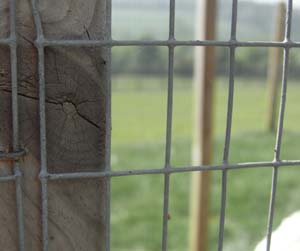 When buying a run, you will need to look at the quality of the wire – small rectangular or square mesh wire is better because foxes can’t get their teeth in to tear at it.
When buying a run, you will need to look at the quality of the wire – small rectangular or square mesh wire is better because foxes can’t get their teeth in to tear at it.
Cheap rabbit wire can be quite thin (especially the cheaper, imported versions from Asia) and I have seen this torn open in weak spots, sadly enough for Mr. Fox to get through. If you decide to use rabbit wire then look for British made, galvanised wire. You certainly ‘get what you pay for’ here but it’s worth doing the job properly.
Latches or bolts to doors are important as well. Galvanised fittings will last years so it is worth paying for these. Screws need to be stainless steel so they don’t rust.
Foxes will dig under a chicken run. If you have problems with foxes during the daytime (or your chickens are not securely locked up in their house at night) then you will need to consider putting your run onto bricks so that Mr. Fox can’t dig underneath. You can put wood chips down inside the run so they can be changed regularly.
There are some smaller runs available that might be customisable to your coop.
Building a Chicken Run
If you are going to build a chicken run, you will need to spend less money but more time. You can of course build a small portable run, much like you would buy and the same things apply to this as I’ve mentioned above but often, people that are building a run go for a fixed run in the corner of the garden.
Rabbit wire is the most economical choice but do be careful with the quality of it. If it isn’t particularly thick, a determined fox will be able to tear at it to get in. a double layer around the lower half of the fence is best if the wire quality is poor.
Ensure that weak points such as where wire joins houses is securely stapled. These areas will need checking regularly for signs of wear and tear. If installed correctly, electric fences are very good at keeping foxes out but on occasions, I’ve seen a run with a fox unable to get out! Sadly the damage has already been done.
Electric fences are not always suitable for every back garden but even in an urban environment where there are people, you can use an electric wire around the top of a fence to stop foxes climbing over.
Chicken wire needs to be burried at least 6 inches with another couple of inches turned outwards but if the soil is loose, you may need to go down 9 inches or more.
A fox can run up a fence (don’t think of a fox being like a dog, they can move more like a cat and can jump and climb really-well) so unless your run has a wire roof, you will need to make the fence at least 6ft high and ideally sloping outwards at the top.
Gates should ideally be made from a solid mesh stapled to a sturdy frame. If this is not possible, at least make sure the gate cannot twist, allowing a predator to get through if pushed in the corners. A fox will easily get through a small hole. If you don’t believe me, go to my page on foxes and watch the film of the fox squeezing under the fence that’s just a few inches off the ground!
Another method of building a large chicken run is to build some ‘chicken run panels’. You can cut all of your wood in one go, with many pieces being the same size. Once you have produced enough panels, you can screw them together making a large run that’s easy to assemble. Keep the panels off the ground so they don’t rot, a brick base on a small strip foundation is perfect but I’ve seen people use rectangular posts on their side and (better) old railway sleepers buried in the ground.
How to Build a Chicken Run
Building a chicken run is really straight forward if you have some basic DIY skills and follow some of the guidance I have given above.
There are a number of chicken run designs that manufacturers use and a few other ‘home made’ runs that are successful. It is difficult to say when a chicken run becomes a ‘fenced off area’ (see my page on fencing chickens if you have a large area to fence off as a run). I tend to call both ‘the chicken run’.
Here, I am going to call the ‘chicken run’ an enclosure that could be 3 to 4 meters long, usually attached to the coop, rather than being ‘around’ the coop and is often covered over.
Start by drawing up the run how you see it in your mind. I like to make notes on my drawing as things pop into my head. This can save you significant time later on if you have thought it through before buying and cutting wood.
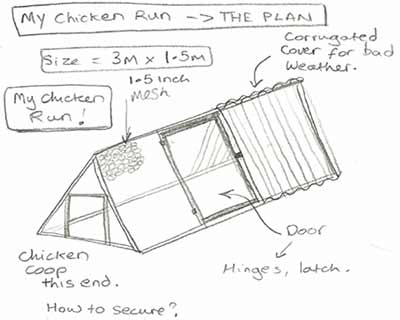 Draw a ‘close up’ of how you are going to make the joints of the chicken run, doors, joint wire and so on.
Draw a ‘close up’ of how you are going to make the joints of the chicken run, doors, joint wire and so on.
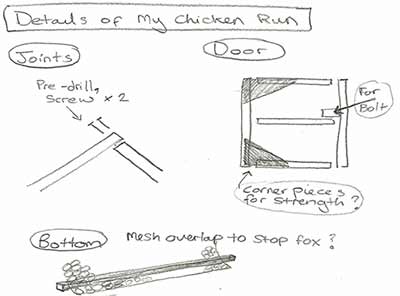 Build a ‘cutting list’ of pieces you will need to build the chicken run. Turn this into a ‘shopping list’ by working out how long your wood needs to be and what sort of thickness you will need. Add hinges, latches, screws, nails, poultry netting and staples to this.
Build a ‘cutting list’ of pieces you will need to build the chicken run. Turn this into a ‘shopping list’ by working out how long your wood needs to be and what sort of thickness you will need. Add hinges, latches, screws, nails, poultry netting and staples to this.
Go and buy your materials, allowing a small amount extra for mistakes!
Chicken Run Plans
One of the best sources of information on chicken runs has been looking through old poultry text books from the 1900’s onwards. These often give chicken house and run plans that have stood the test of time. Many have fold out pages with the plans on so providing you are happy to work in inches and feet, for a couple of searches on eBay and a few pounds, you can soon have quite a few chicken run plans.

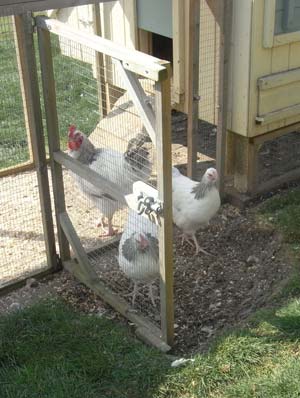
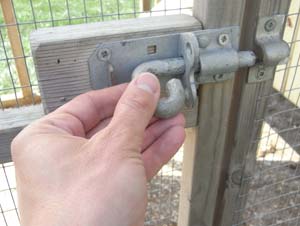



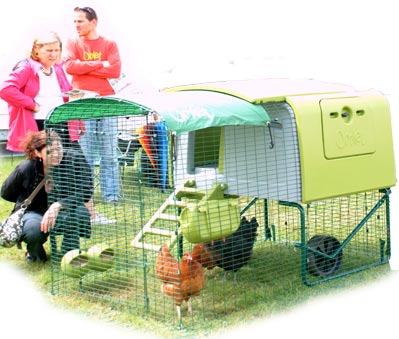


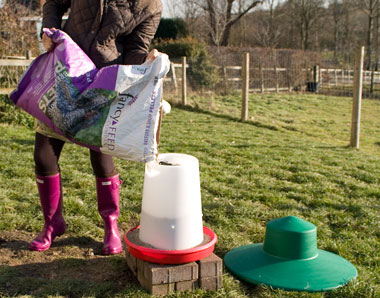
Hi. We’re shortly going to purchase 4 or 5 bantams after a break from chickens for the past few years (yep, you’re right , we missed having them around). Previously we had the birds on a brick base with a deep litter of wood shavings but that location is no longer an option. This time we’re thinking of siting the run (about 1.75 sq m) on a section of compacted soil covered in gravel (about 2″ deep). Although the birds will have a fair amount of access to the whole garden, there will be times (Spring when we have young seedlings) when they will be confined to barracks. With a view to maintaining as hygienic a run as possible, would it be better to lay slabs on top of the gravel. Although the run will be covered, it will be exposed to the elements on 2 sides and thus deep litter would easliy become wet. Many thanks for any help or ideas.
If you can cover the run to keep it dry and then board around the base so that a deep litter system can be used, you can fill the run with six inches of softwood chippings, or course sand. If the run is open to the rain then gravel is your best option. This allows birds to scratch but can be cleaned up daily and replaced periodically to keep the run clean.
Congratulations on a very good website!
I am new to keeping hens and I have just obtained three Rhode Rock pol birds.
The ‘on grass’ run I have is fairly small at 2mts X 1.5mts. I do intend to let them roam the garden when they have got used to their coop and run, but I am concerned to keep the run clean in the meantime. Apart from scraping up poo, is there a need to disinfect, or would you suggest a layer of straw that can be periodically replaced?
The run will soon turn to mud. When it does, it will be better to cover it and put some boarding around the base, then a deep litter system can be used, you can fill the run with six inches of softwood chippings, or course sand. The birds can scratch around and it can be cleaned up and replaced from time to time to keep the run clean.
Hi – A question about advice on siting a Run , could a run be sited on concrete covered in softwood chippings or would grass / soil be the preffered option , I’m thinking about preventing foxes digging under the run
thanks Chris
Yes, if covered, boarding the bottom and filling with sand / shingle / wood chippings works well – you can change it every so often and they still get to scratch. Grass soon turns to mud in a small area.
Hi, I have enjoyed reading your website and as yet do not have any chickens. I live in Spain and have quite a large roof terrace on the top of my house and intend to let them have free run of this space but it does get very hot – do you think this would be a problem? Obviously I would erect some kind of shaded area. The floor is completely tiled and although I can get the chicken house sorted I’m not sure about the covering for the floor. What do you advise? Regards Jacky
Chickens can handle the cold far better than the heat. The roof would get very hot I’d imagine, probably too hot for them. Concrete holds the heat too – I bet you couldn’t walk on it bare foot in the heat of the day?
I don’t think this would work to be honest – even with a large shaded area, I think the concrete would still warm up from other parts of the house that are in the sun – they would find it very difficult…
They would also need something to scratch in – wood chippings for example.
Hello again,
My 3 hybrids are now 23 weeks old and laying well. We have a large run for them and they have access to food, water, perches inside and out, dust bath and hanging treat sticks or green veg to try and keep them amused! However, my dominant Nera has just started to feather peck the Skyline who is becoming extremely stressed (as am I!). I am not quite sure how to deal with it – any advice would be welcome. It would not be easy to separate them at this stage.
Many thanks Tarcy
Reply